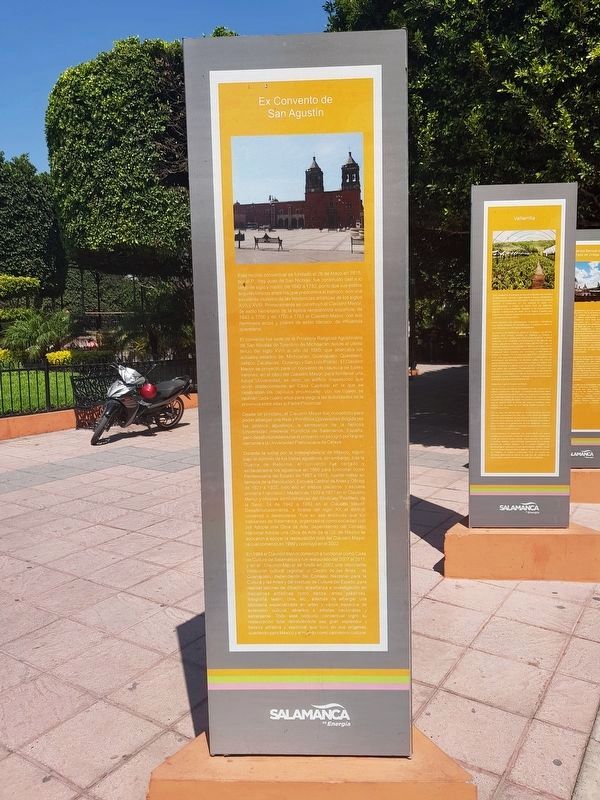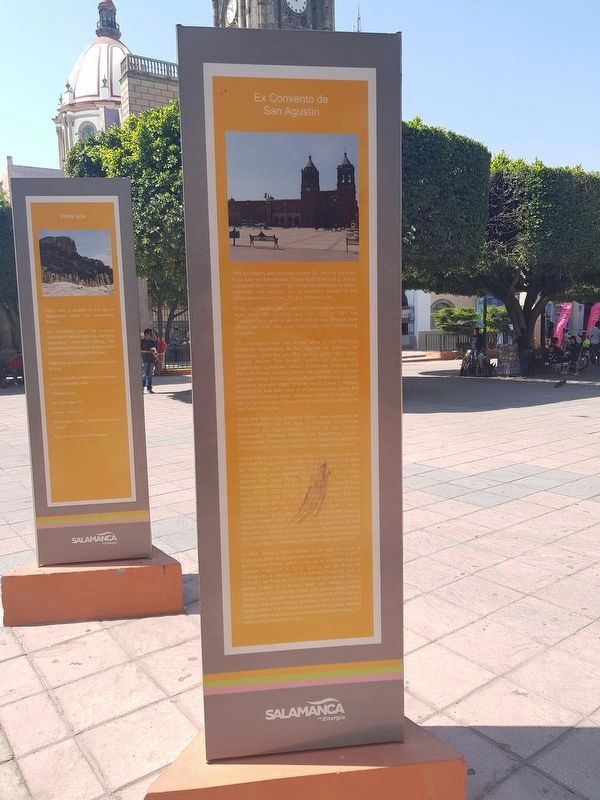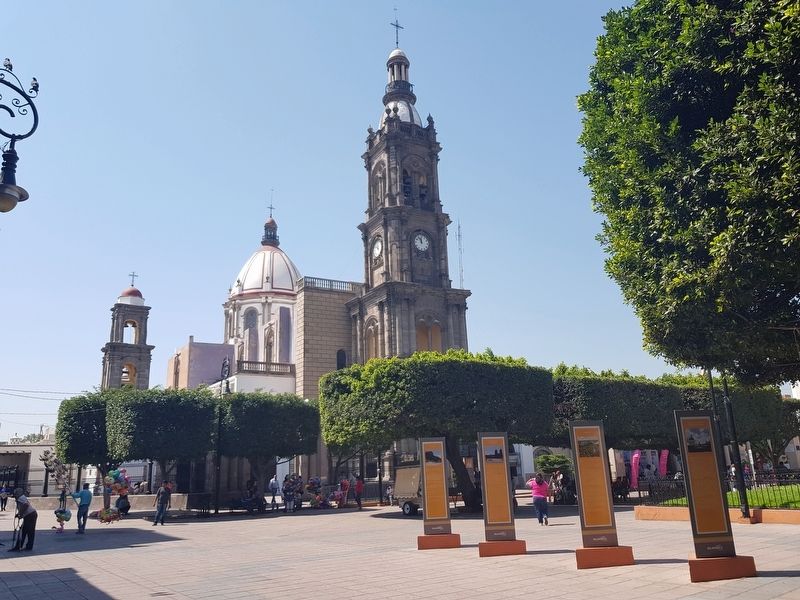Salamanca, Guanajuato, Mexico — The Central Highlands (North America)
The Ex-Convent of Saint Augustine
Inscription.
El convento fue sede de la Provincia Religiosa Agustiniana de San Nicolás de Tolentino de Michoacán desde el último tercio del siglo XVIII al año de 1860, que abarcaba los actuales estados de Michoacán, Guanajuato, Querétaro, Jalisco, Zacatecas, Durango y San Luís Potosí. El Claustro Menor se proyectó para un convento de clausura de frailes varones, en el caso del Claustro Mayor, para fundarse una futura Universidad, es decir, un edificio majestuoso que sirvió posteriormente en Casa Capitular en la que se celebraban los capítulos provinciales, con los cuales se reunían cada cuatro años para elegir a las autoridades de la provincia entre ellas el Padre Provincial.
Desde un principio, el Claustro Mayor fue concebido para poder albergar una Real y Pontificia Universidad dirigida por los propios agustinos, a semejanza de la famosa Universidad Medieval Pontificia de Salamanca, España, pero desafortunadamente el proyecto no se logró por la gran cercanía a la Universidad Franciscana de Celaya.
Durante la lucha por la Independencia de México, siguió bajo el dominio de los frailes agustinos, sin embargo, tras la Guerra de la Reforma, en convento fue cerrado y exclaustrados los agustinos en 1860 para funcionar como Penitenciaria del Estado de 1867 a 1915, cuartel militar en tiempos de la Revolución, Escuela Central de Artes y Oficios de 1921 a 1925, todo ello en ambos claustros, y escuela primaria Francisco I. Madero de 1929 a 1973 en el Claustro Menor y oficinas administrativas del Sindicato Petrolero de la Secc. 24 de 1944 a 1963 en el Claustro Mayor. Desafortunadamente, a finales del siglo XX el edificio comenzó a deteriorarse. Fue en ese entonces que los habitantes de Salamanca, organizados como sociedad civil por Adopte una Obra de Arte, dependiendo del Consejo Nacional Adopte una Obra de Arte de la Cd. De México se avocaron a apoyar la restauración total del Claustro Mayor, la cual comenzó en 1999 y concluyó
en el 2002.
En 1984 el Claustro Menor comenzó a funcionar como Casa de Cultura Salamanca y fue restaurado del 2007 al 2011, y en el Claustro Mayor se fundó en 2002 una importante institución cultural regional. El Centro de las Artes de Guanajuato, dependiente del Consejo Nacional para la Cultura y las Artes y del Instituto de Cultura del Estado, para realizar labores de difusión, enseñanza e investigación en disciplinas artísticas como danza, artes plásticas, fotografía, teatro, cine, etc., además de albergar una biblioteca especializada en artes y varios espacios de extensión cultural, abiertos a artistas nacionales y extranjeros. Todo ese conjunto conventual logró su restauración total devolviéndole ese gran esplendor y belleza artística y espiritual que tuvo en sus orígenes, quedando para México y el mundo como patrimonio cultural.
(Ex-Convento de San Augustín)
with its beautiful arches and baroque style pillars was built with clear influences from neighboring Queretaro.
The monastery was the central office of the Provincia Religiosa Agustiniana de San Nicolas de Tolentino de Michoacan since the late 18th century up to 1860, which spread across the current states of Michoacan, Guanajuato, Queretaro, Jalisco, Zacatecas, Durango and San Luis Potosi. Claustro Menor was planned as a cloister for male monks. As for Claustro Mayor, the aim was to found university at a later stage. In other words, it was a majestic building that was later used as a Casa Capitular where the provincial meetings were celebrated every four years, in which the authorities of the province were chosen along with the Padre Provincial.
From the beginning, Claustro Mayor was conceived as accommodation for the Real y Pontificia Universidad managed by Augustinians, similar to the famous Universidad Medieval Pontificia de Salamanca, Spain. Unfortunately, the project was not completed because of the close proximity of the Universidad Franciscana de Celaya.
During Mexico's Independence War, it remained under the authority of Augustinian monks. However, after the Guerra de Reforma, the monastery was closed and the Augustinians were expelled in 1860, and the building became the State Prison from 1867 to 1915, then headquarters during the Revolution, Arts & Crafts School from 1921 to 1925, and the Francisco I. Madero Primary School from 1929 to 1973 at Claustro Menor and the administration offices of the Oil Production Trade Union (Section 24) from 1944 to 1963 at the Claustro Mayor. Unfortunately, at the end of the 20th century the building started to deteriorate. Is (sic, It) was only when the population of Salamanca, organized under the Adopte una Obra de Arte non-profit, a member of the Adopte una Obra de Arte Nation Council based in Mexico City, advocated the total restoration of Claustro Mayor, which began in 1999 and ended in 2002.
In 1984, Claustro Menor started to be used as Casa de Cultura de Salamanca and was restored from 2007 to 2011, and Claustro Mayor was founded as an important cultural regional institution in 2002; Centro de las Artes de Guanajuato, a member of the Consejo Nacional para la Cultura y las Artes and the Instituto de Cultura del Estado, whose mission is to spread, teach and research artistic disciplines such as dance, plastic arts, photography, drama, cinema, etc., besides hosting a specialized library in arts and several spaces for cultural activities, open to national and foreign artists. This monastery has now been totally restored back its original artistic and spiritual splendor and beauty, for Mexico and the world to enjoy.
Topics. This historical marker is listed in these topic lists: Churches & Religion • Colonial Era • Man-Made Features. A significant historical date for this entry is May 26, 1615.
Location. 20° 34.126′ N, 101° 11.965′ W. Marker is in Salamanca, Guanajuato. Marker is on Calle Río Lerma just north of Calle Revolución, on the left when traveling north. Touch for map. Marker is in this post office area: Salamanca GTO 36700, Mexico. Touch for directions.
Other nearby markers. At least 8 other markers are within walking distance of this marker. Hacienda of the Cañada de Ortega Sanctuary (here, next to this marker); Valtierrilla (here, next to this marker); The Lord of the Hospital (within shouting distance of this marker); The Founders of Salamanca (within shouting distance of this marker); The Main Garden or Constitution Square (within shouting distance of this marker); The House of the Inquisitor (about 120 meters away, measured in a direct line); The Temple of Saint Augustine (about 150 meters away); Miguel Hidalgo y Costilla (about 180 meters away). Touch for a list and map of all markers in Salamanca.
More about this marker. A copy of this marker titled 'The Augustinian Ex-Convent of San Juan de Sahagún' can also be seen nearby to the north of the actual Augustinian Ex-Convent of San Juan de Sahagún.
Credits. This page was last revised on March 24, 2018. It was originally submitted on March 24, 2018, by J. Makali Bruton of Accra, Ghana. This page has been viewed 137 times since then and 8 times this year. Photos: 1, 2, 3. submitted on March 24, 2018, by J. Makali Bruton of Accra, Ghana.


